Benthos H2
Almost 60 years after Aquastar most likely and inadvertently started the drive to invent a Helium Escape Valve (HEV) equipped dive watch, they have finally released a watch with just such a valve. Say hi to the Benthos Heritage H2.
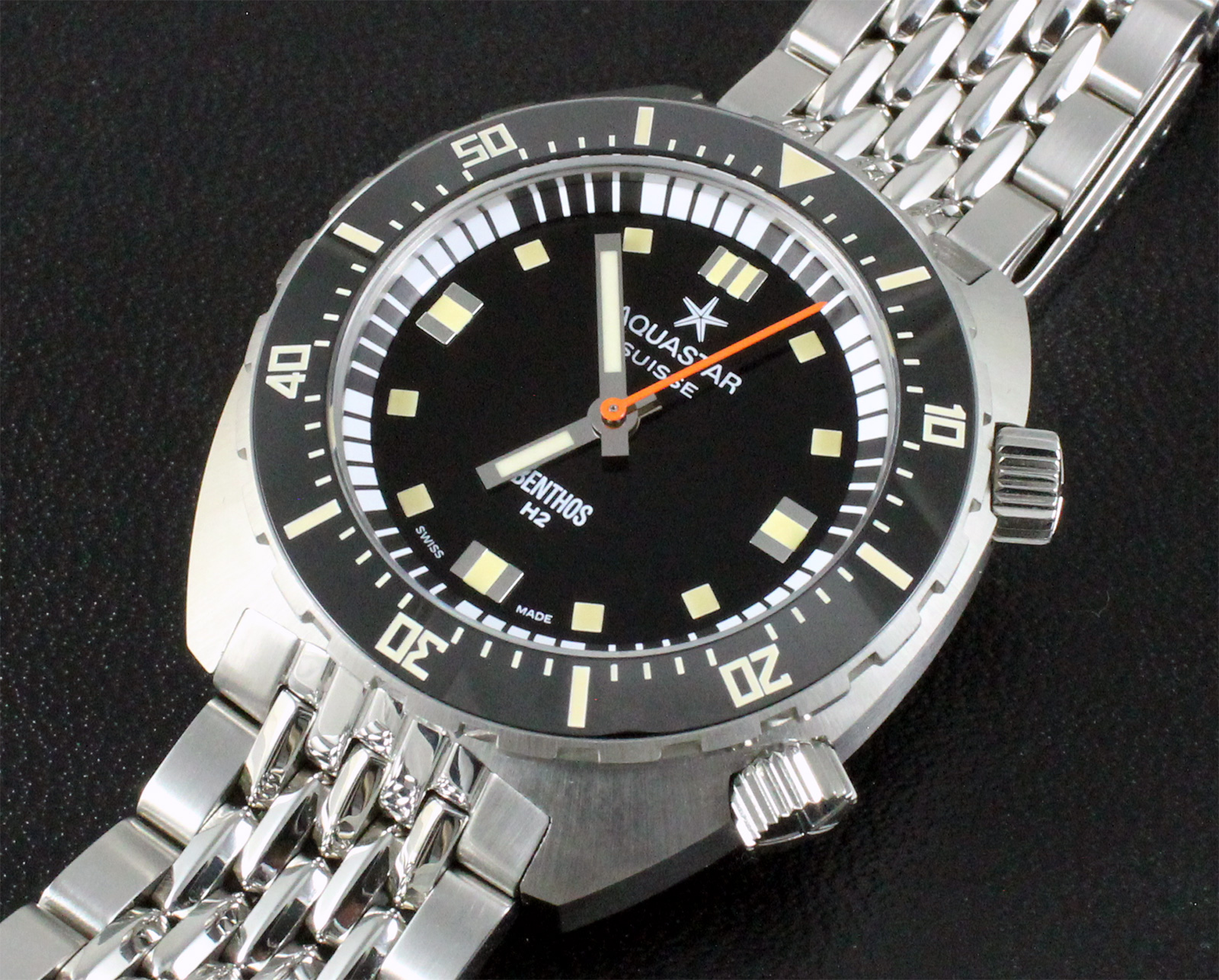
But before we take an indepth look at the watch, here is a little bit of history. The HEV chapter in my new vintage DOXA book is 27 pages. I’m condensing the gist of it into a couple of paragraphs.
Shameless plug for the book: DOXA – A History of the Vintage – SUB
Saturation diving allows humans to live and work at sustained depths for days, weeks or even months at a time. The technique uses the principle that after about 24 hours at any working depth, a diver’s body becomes saturated with dissolved gases and reaches an equilibrium. Once the body is saturated, decompression time is the same regardless of how much time has been spent underwater. In 1919, Professor Elihu Thompson reasoned that decompression sickness might be avoided if the nitrogen in the diver’s air mixture were diluted with helium and that is what is now used for saturation diving.
Sometime around 1967 (actual date cannot be confirmed) U.S. Navy SEALAB Aquanaut Bob Barth mentioned to another diver named T. Walker about how when saturation divers went through decompression after weeks at depth, the crystals would shoot off their watches due to a build up of helium. Lloyd shared this information with Rolex and they began designing what would become the Sea-Dweller. At the same time DOXA were developing the SUB 300T Conquistador which became the first commercially available HEV equipped dive watch.

I never found any information about what saturation program Bob Barth was talking about but it is most likely to have been Conshelf 3 which operated in September 1965, or what dive watches had their crystals come off. I believed it was the Aquastar Deepstar and when I read the article in the April 1966 issue of National Geographic on Conshelf 3, I realized that it all but confirmed it. Most, if not all the Cousteau Oceanauts wore one and it was also constructed using the susceptible tension ring crystal. There is a paragraph in the National Geographic article under the title: Watches Explode as Pressure Drops which says:
During decompression, Laban heard a small muffled explosion. In his sea chest, where it had lain unworn since Day Two, was his impressive new deep-sea Wristwatch with a shattered crystal. The timepiece had withstood water and exceptional pressure, but had been infiltrated by helium. When the house pressure fell, the helium expanded and smashed its way out. As Laban looked at his broken timepiece, he heard his comrades’ watches exploding one by one.
Years later Bob Bart admitted that in total only 4 to 5 watches had an issue with crystals popping off. It’s quite ironic that it was very likely that one of Aquastar’s watches helped initiate and drive forward the research and development of the HEV, yet they never produced a HEV watch. Until now.
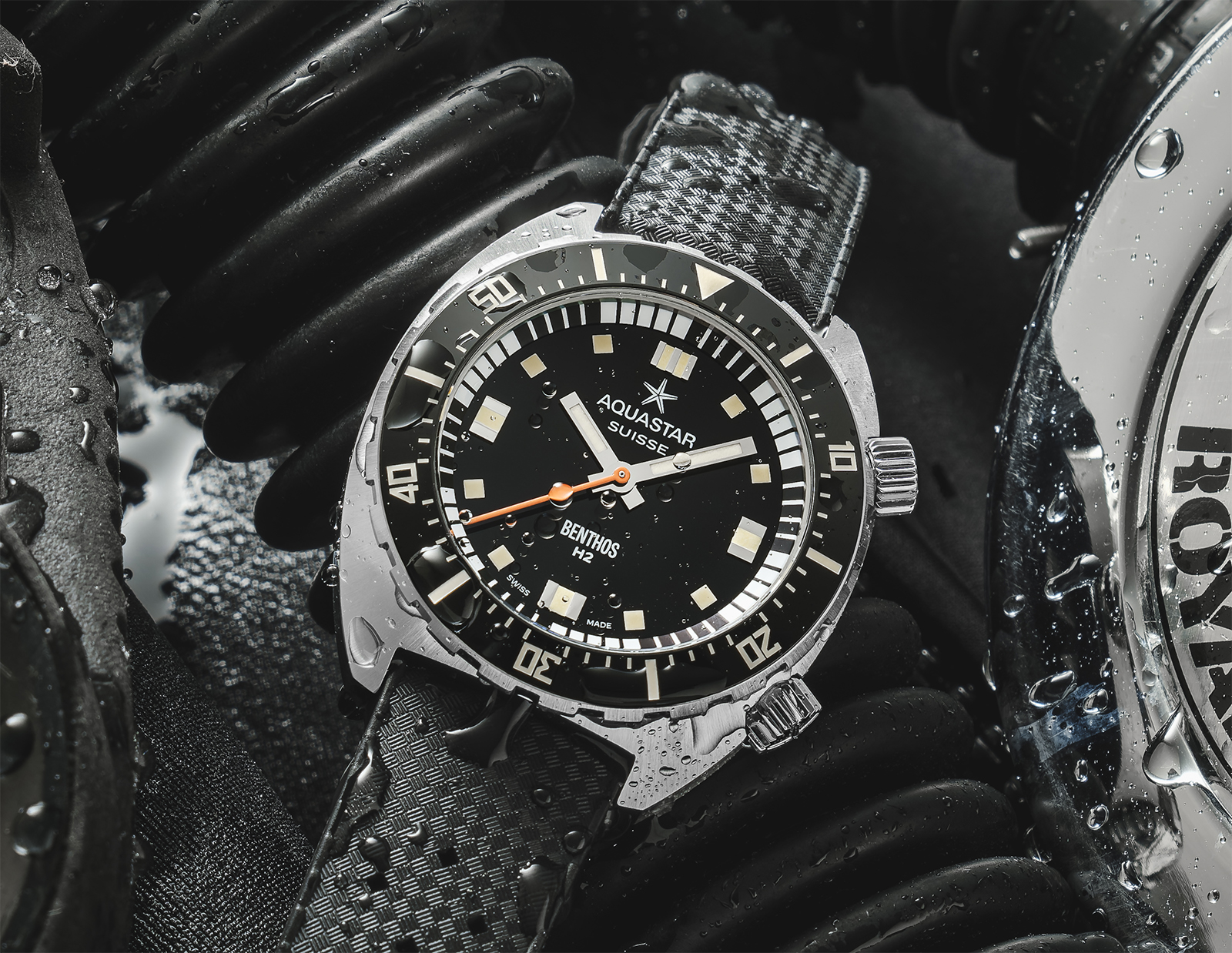
So let’s look at the Benthos H2. It certainly has the Benthos Design language. Distinctive shape with blocky minute chapter ring. 120 click bezel with ceramic insert. Crown at 2 o’clock. Crown at 4 o’clock. Wait, what? Crown at 4 o’clock. The vintage Benthos 500 design has a Totalizer pusher at 4 o’clock not a crown. The modern Benthos 500 has a crown at 4 but that was dictated by the configuration of the new Aquastar calibre movement. So what gives with the extra crown at 4 o’clock? Well, the discussion about HEVs should have given the game away. The 4 o’clock crown is the Helium Escape Valve.
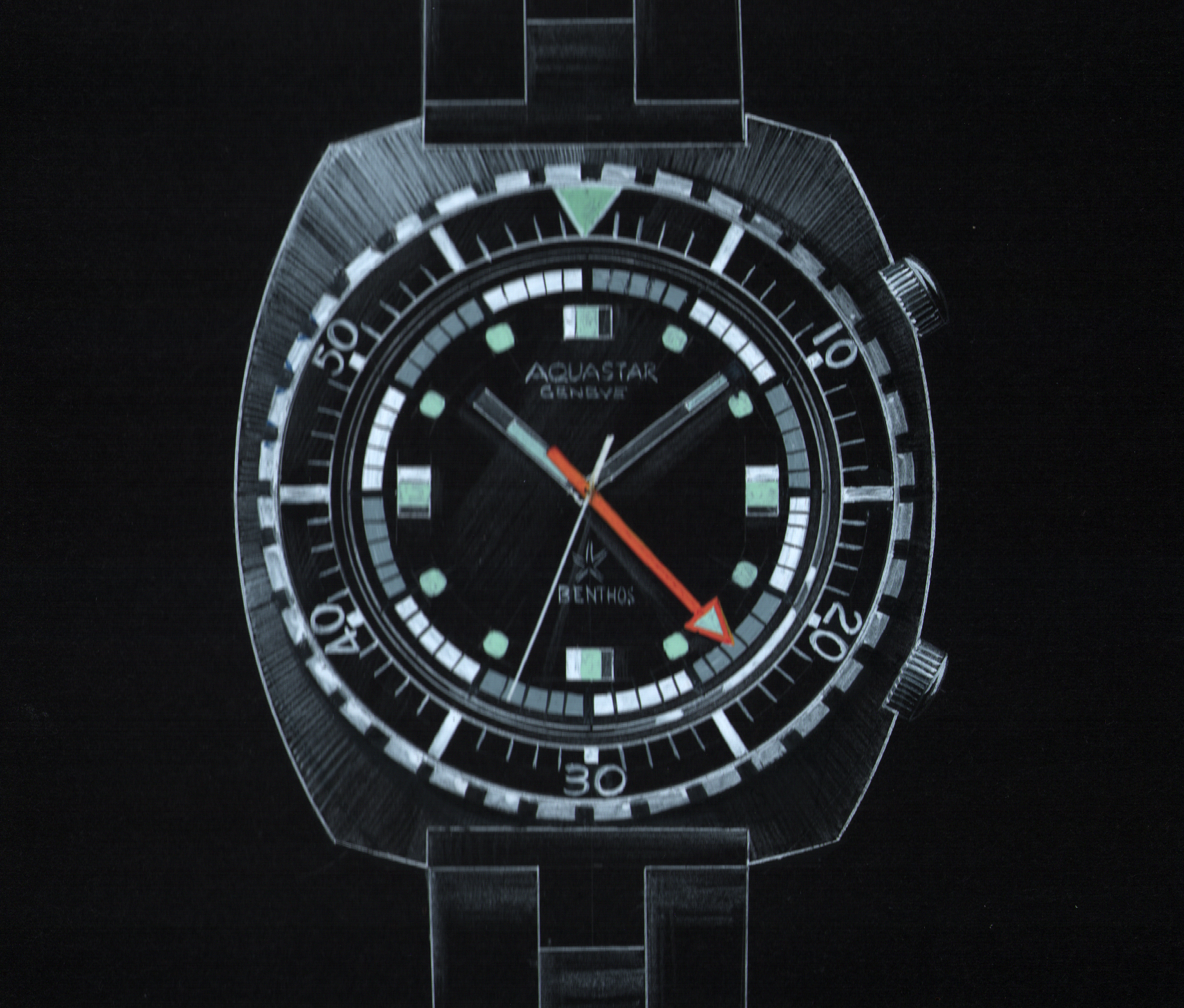
I want to take a minute here and refer to the drawing above. Anyone who has my A Dive Into Time book will know the image as a Benthos 500 design drawing from May 1968. Note the 4 o’clock crown. Nope its not an HEV. It is the Totalizer pusher. It utilized a screwdown crown for water-tightness.
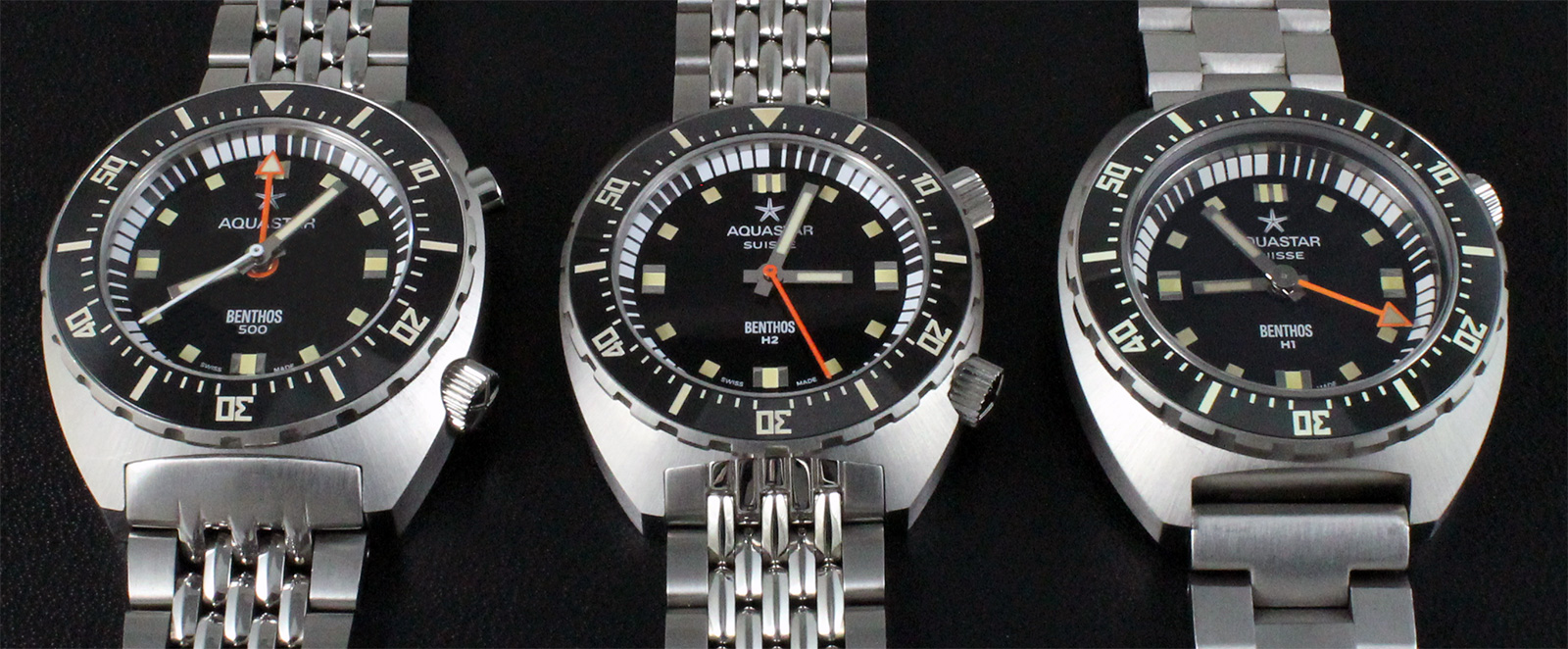
So let’s get something out of the way real quick. The H2 does not have a Totalizer. It is a “3 hander” and it is different to the H1 in that it does not have the distinctive red triangle hand. The triangle hand was used as the Totalizer hand on the 500, but when the H1 was designed it was decided to use a similar hand to maintain the same design language. This was before the new Benthos 500 was released and now that it is available the decision was made to drop the triangle hand from the 3 hander Benthos Heritage models.
I was a little surprised the first time I saw the H2 and it didn’t have the red triangle hand. I’ve mocked up the following image to show what it would have looked like with one. The triangle hand keeps the classic look but the new non triangle hand looks a bit “cleaner” and really the more I look at it, I think it was the right choice. I did “shop” an image to see what a white seconds hand would have looked like and while it was a good look it didn’t have the red hand Benthos design aesthetic.
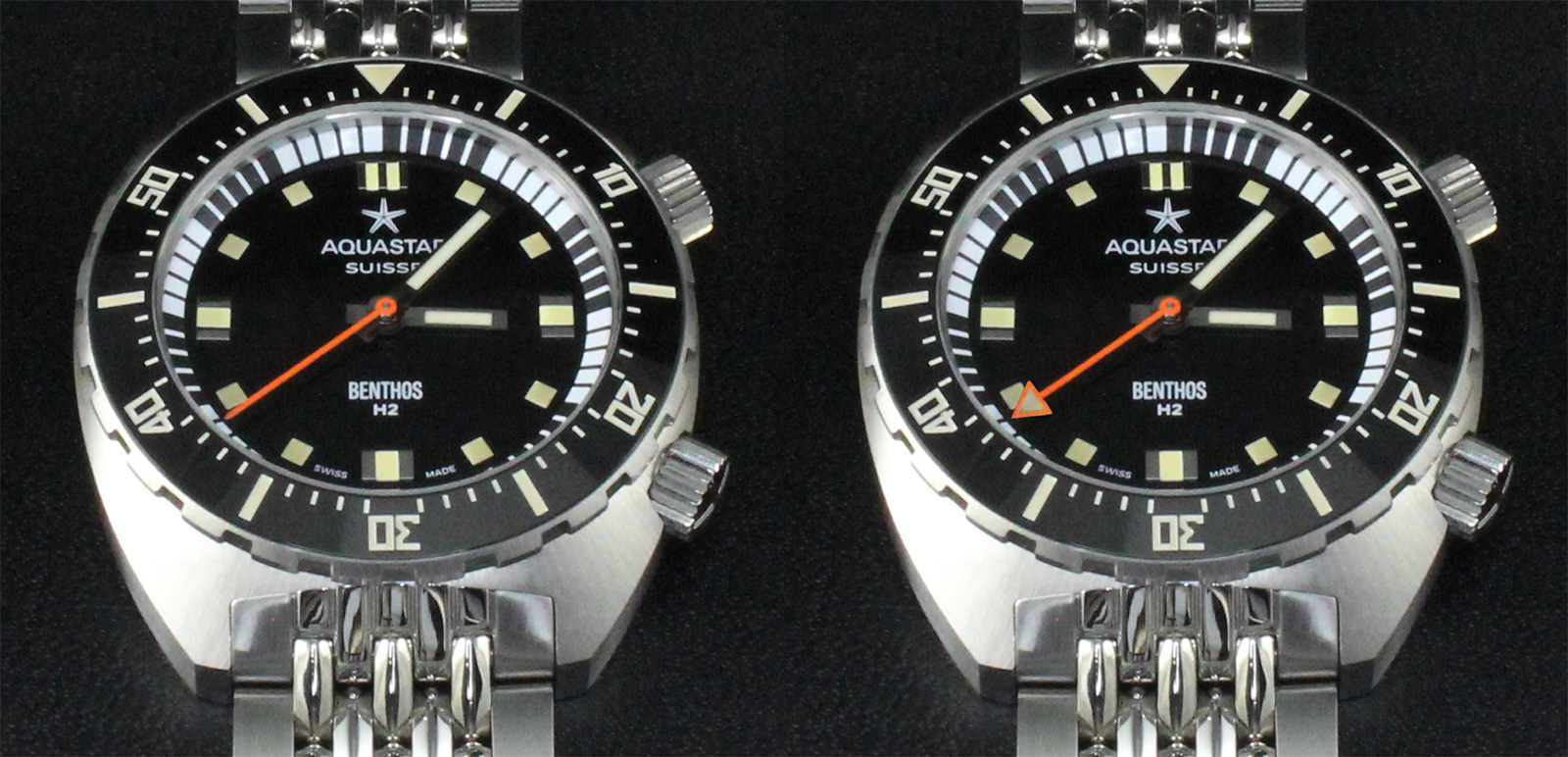
The H2 uses a Sellita SW200-1 movement. It is automatic with a 28,800 bph / 4Hz beat rate contains 26 jewels and has a power reserve of 39 to 41 hours. They are pretty much bulletproof and will give good service over a lifetime and parts can literally be found for them under the nearest hedge so any future servicing won’t be a problem.
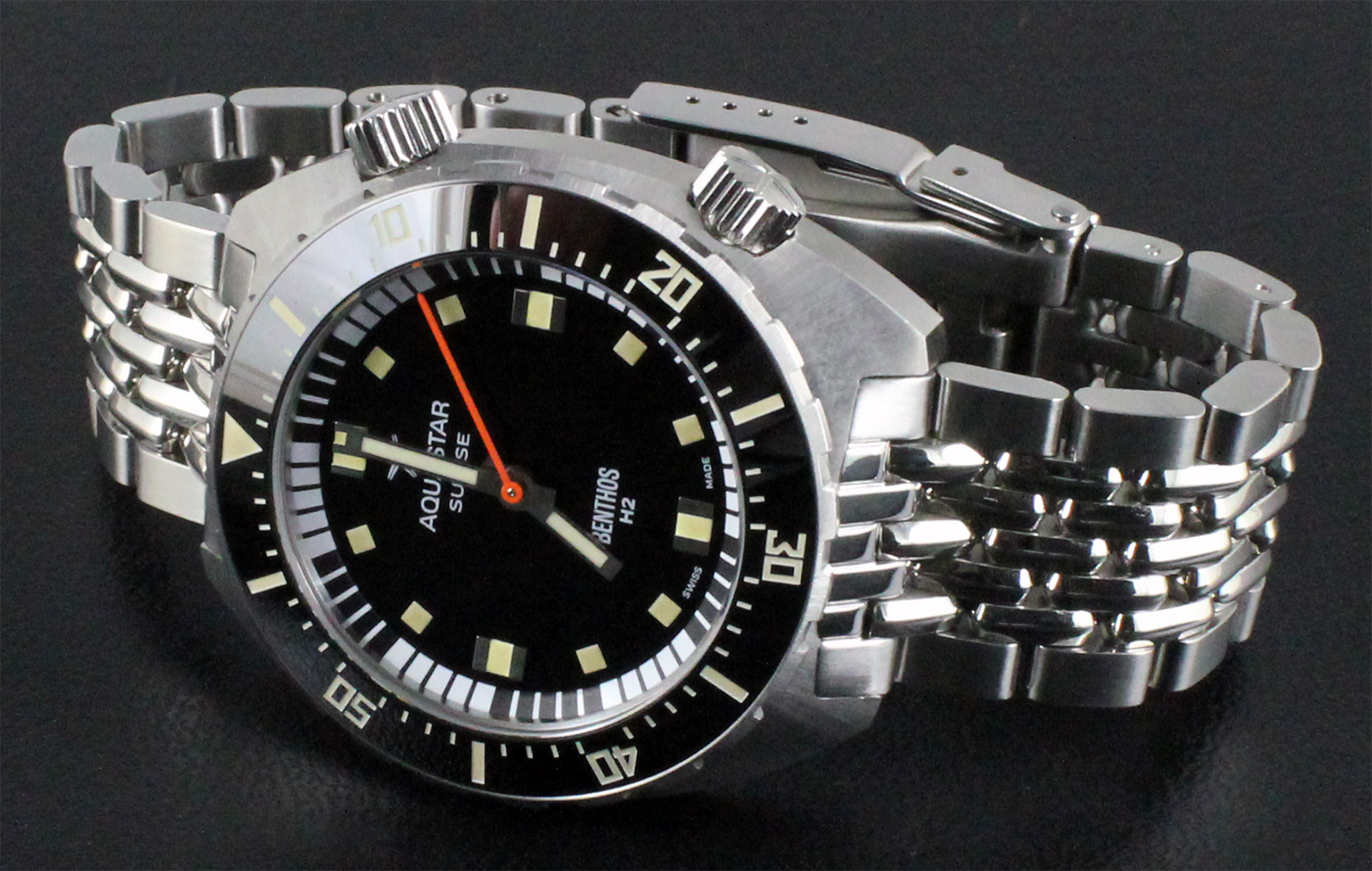
However, I do feel a little bit of a disappointment at the use of the Sellita S200 movement. Aquastar had been using a La Joux-Perret G100 movement in the Aquastar 60 but it looks like they have bowed to the movement snobs and went back to the Sellita S200. Technically the LJP is a superior movement. It is hand wind and automatic, hacks, 24 Jewels, runs at 28,800bph and has an amazing 68 hour power reserve. It also has some innovations over the standard ETA 2824-2 and Sellita SW200-1. These include a rotor which is made from a solid piece of tungsten and a number of the wheels / cogs are made from CuBe (Beryllium Copper) and the shock protection for the balance pivots is made by Kiff, one of the two largest producers of shock protection in Switzerland. Sure people worry about longevity and serviceability but LJP is owned by Citizen, the G100 is based on a Miyota caibre and are there many interchangeable parts. It’s funny how things go. It was always: ETA is the best. No one knew much about Sellita so they were deemed inferior. Then ETA stopped being available so Sellita became the favorite. No-one knew anything about Soprod so they were deemed inferior. Now, no-one knows much about LJP so they are deemed inferior. In fact the G100 is dimensional compatible to the ETA 2824-2 and Sellita SW200-1 (25.6mm diameter, same dial feet positions and the hand sets are the same size). I think LJP need to up their marketing and awareness game. I’ll bet 10 years for now when Aquastars come up for sale the ones with LJP movements will command a higher price, but I’m sure people will be happy with the Sellita S200 in the new H2.
Comparing The H2 prototype with other Aquastar watches and a few others we can see that it is getting into the Omega and Rolex range for thickness and weight. A 40mm case could be considered small but the H2 is the same lug to lug length as the DOXA SUB 300T and Synchron Poseidon.
| WIDTH (mm)
(without crown) |
LENGTH (mm) | HEIGHT (mm) | LUG WIDTH (mm) | WEIGHT
(with bracelet for 6.75″ wrist) (grams) |
|
| BENTHOS H2 | 40 | 45 | 12.3 | 20 | 157 |
| BENTHOS H1 | 42 | 47 | 16 | 20 | 178 |
| NEW BENTHOS 500 | 42 | 47 | 15.6 | 22 | 191 |
| VINTAGE BENTHOS 500 | 42 | 47 | 16 | 20 | 178 |
| DEEPSTAR 39 | 39 | 49 | 17 | 21 | 175 |
| AQUASTAR 60 | 37 | 47 | 13.3 | 19 | 135 |
| OMEGA SEAMASTER | 43 | 47 | 12 | 20 | 150 |
| DOXA SUB 300T | 42.5 | 45 | 14.5 | 20 | 163 | ROLEX GMT (5 Digit Case) | 40 | 46.8 | 11.9 | 20 | 122 | SYNCHRON POSEIDON | 42.2 | 45 | 14.6 | 20 | 169 |
| SEIKO MONSTER | 42.5 | 47.5 | 12.8 | 20 | 165 |
Here are a couple of comparative images.
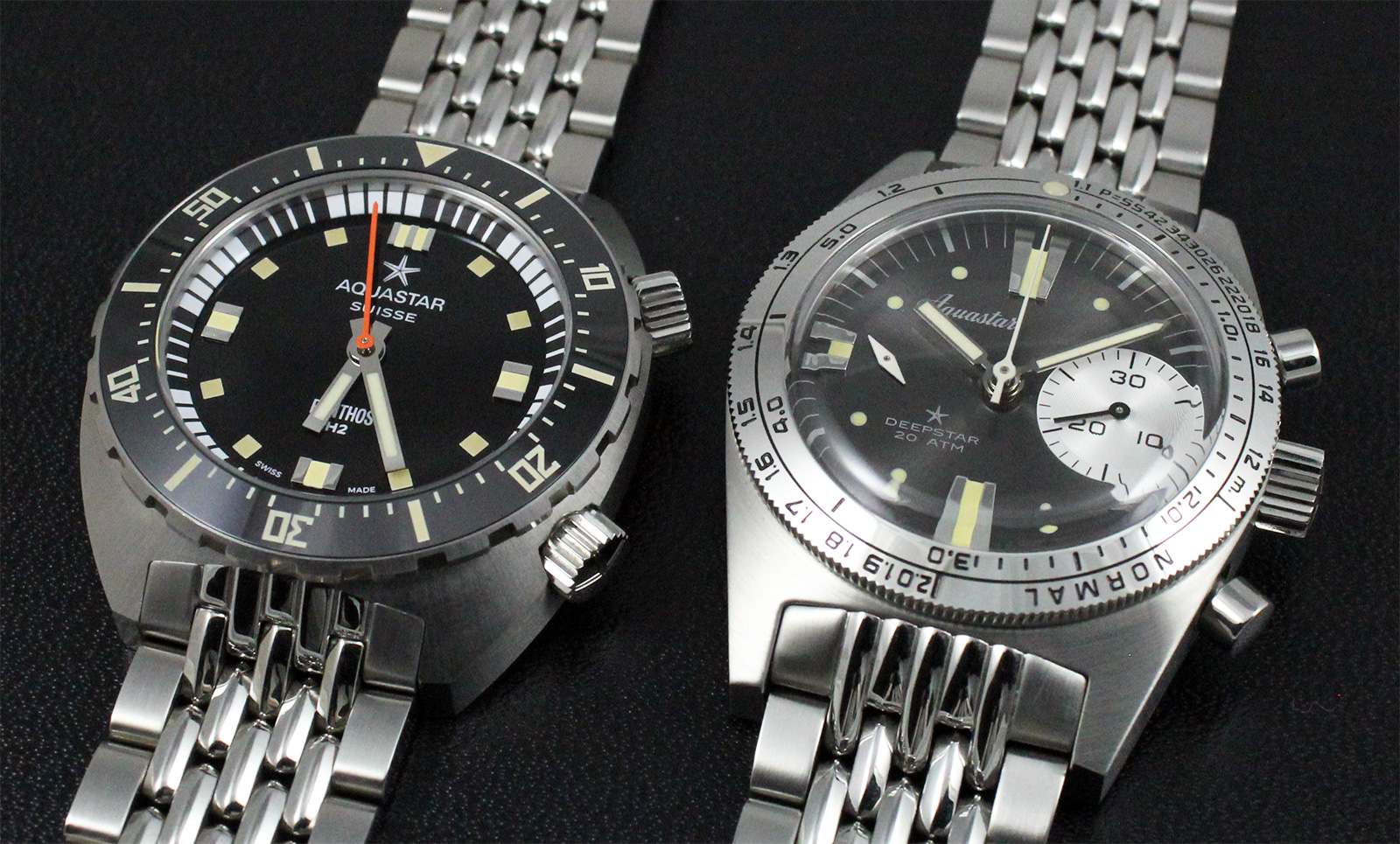
Deepstar 39
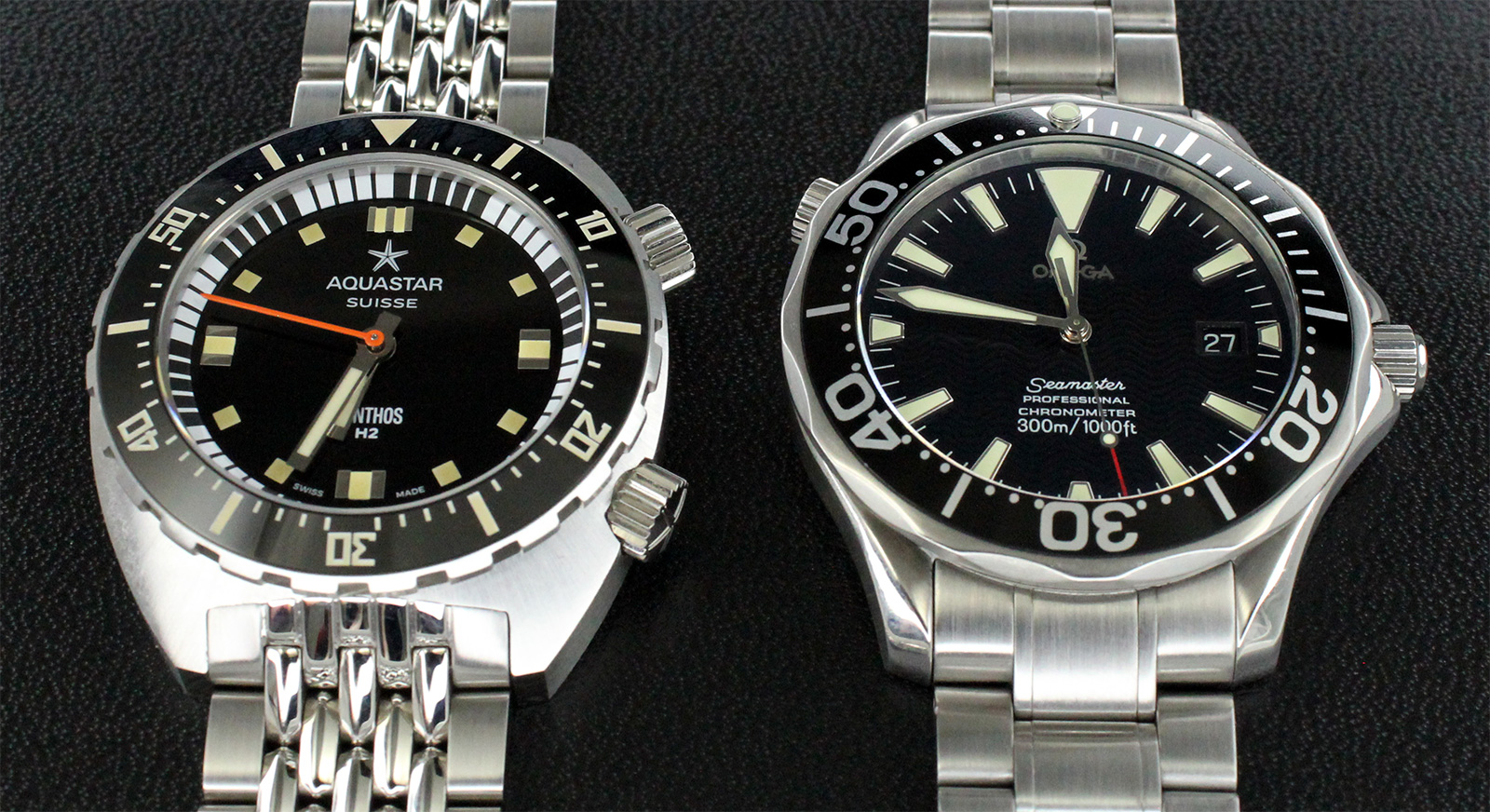
Omega Seamaster 300

DOXA SUB 300T

Synchron Poseidon (Note the flat endpieces)
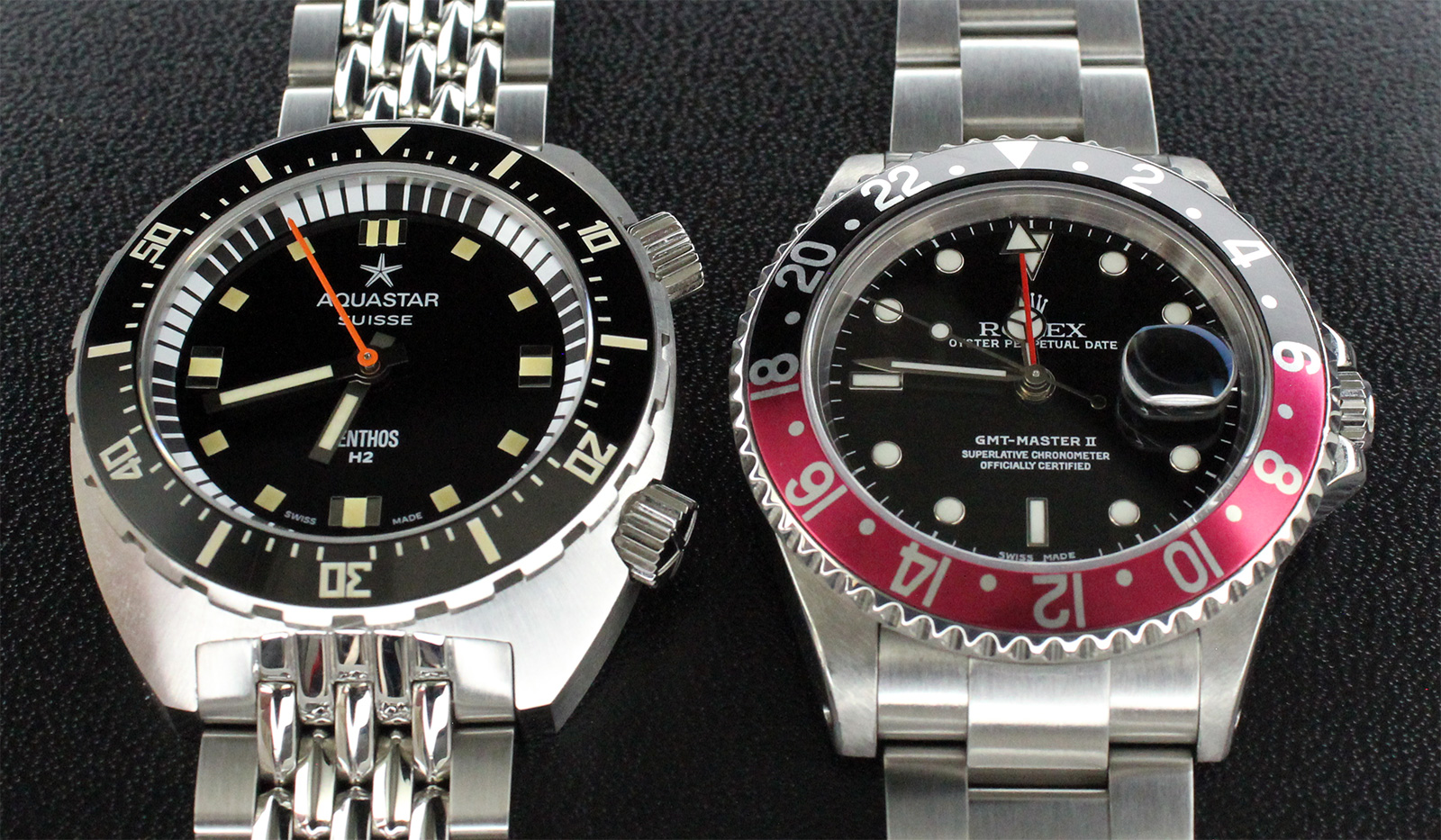
Rolex GMT
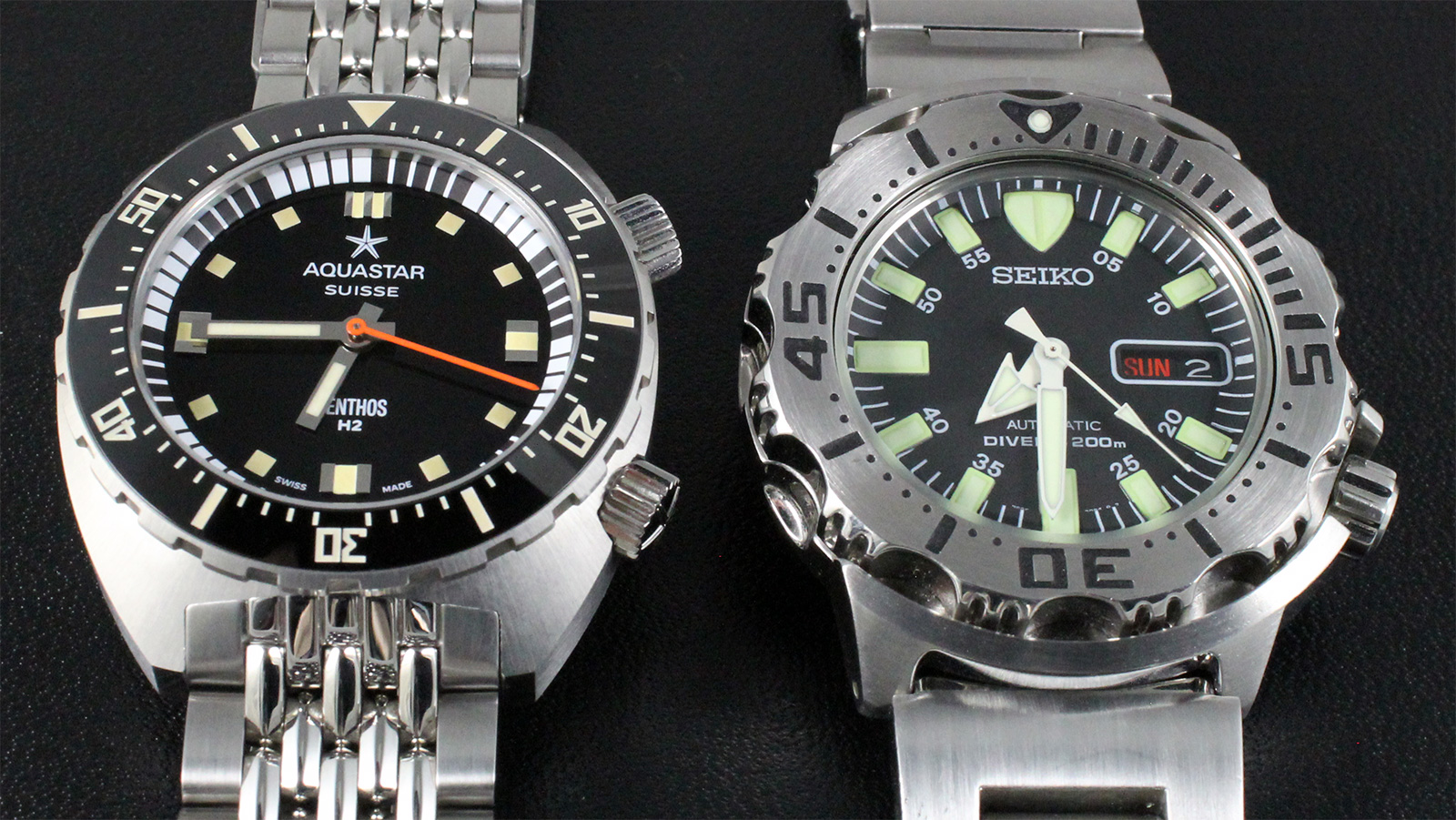
Seiko Black Monster
I’ve always championed that a thinner watch and a flatter caseback go a long way to increasing wearability and over the last couple of years there has been a definite trend towards smaller and more wearable watches, although I think the pendulum is swinging a bit too far now. Aquastar has looked at ways of making the Benthos range more wearable and I think they have hit the sweet spot with the H2.
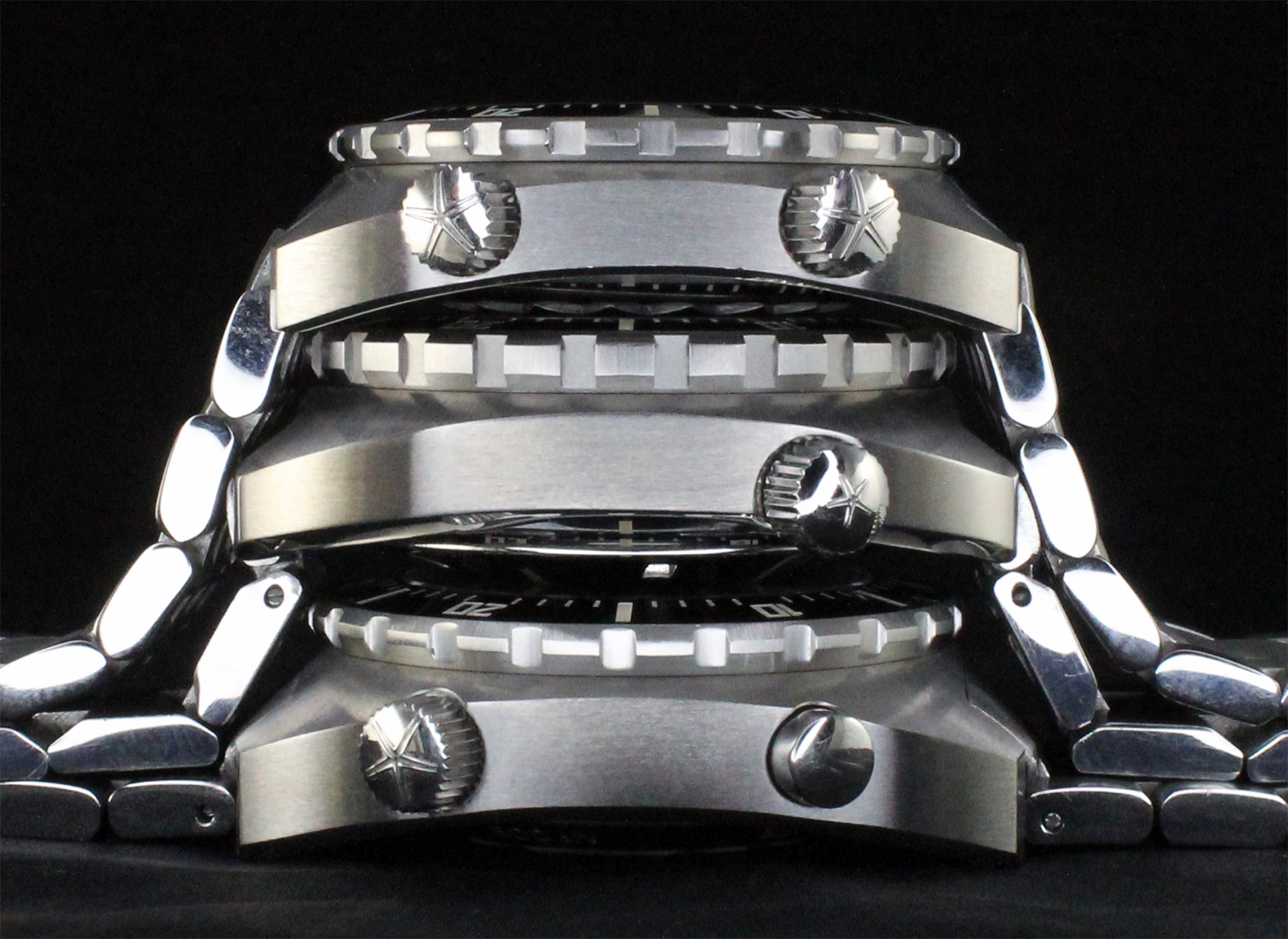
From top to bottom: H2, H1, 500 Founder’s Edition
The midcase has shrunk to 40mm wide and 45mm lug to lug and the height has been reduced. 12.3mm on the prototype but listed as an incredible 11.9mm for the production version. This was achieved by replacing the H1’s 6 slot opener caseback with the traditional 18 star caseback and also reducing the chapter ring height and also the sapphire crystal thickness. The H2 prototype caseback is blank.
Note in the image above how the bezel grip profile has changed from the H1 to H2. The H2 is similar to the Benthos 500 Founder’s Edition. The H2 bezel moves with a satisfyingly “solid” click and is tight with no lateral or backwards motion.
One other thing to note in the caseback image below is how the underside of the case has changed from the H1. The H1 is polished whereas the 500 and H2 are brushed. Its a small detail but I really liked the polished underside of the H1. It just seemed to smack of more attention to detail in the design and production of the watch.
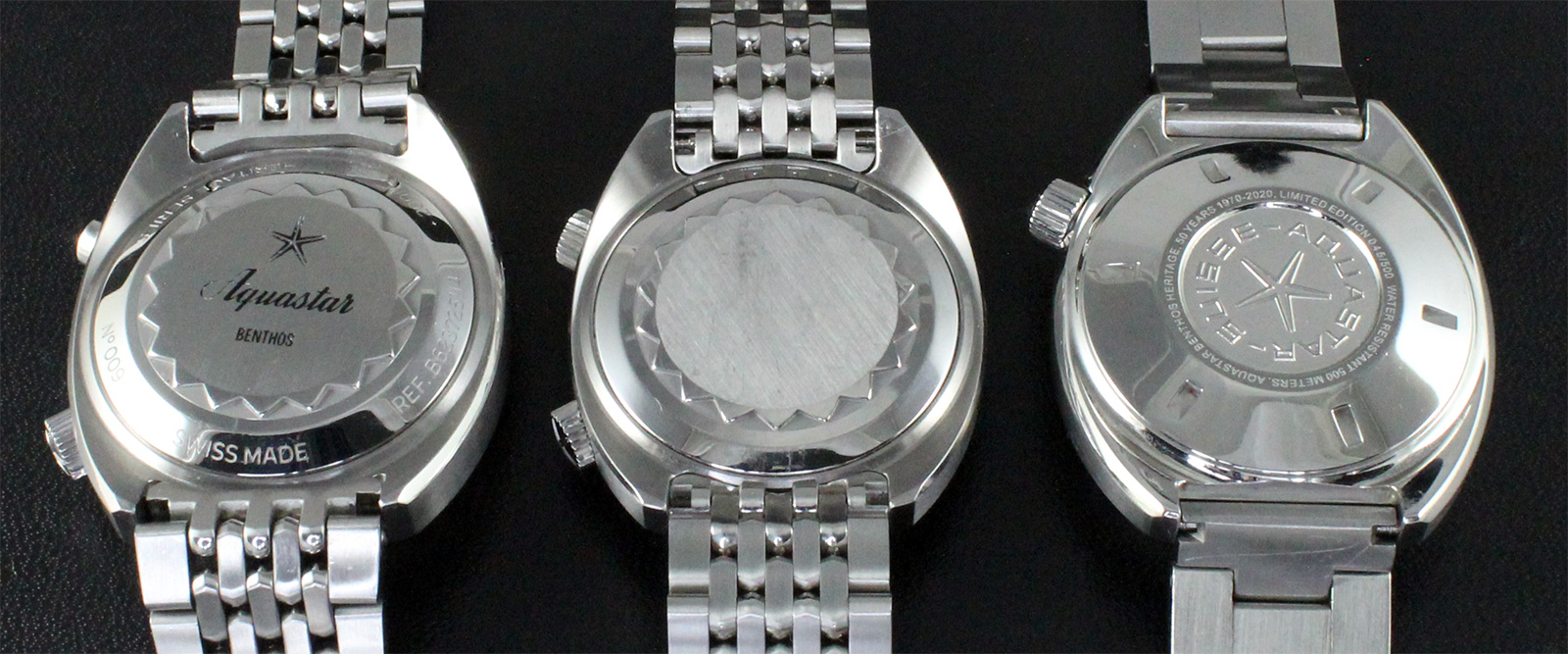
However, the H2 still has a 300 meters / 30 ATM depth rating. And here’s a thing the metallurgists amongst you will love, the H2 case is made from 904L Stainless Steel. 904L has higher Chromium and Nickel content than the “bog standard” 316L. That imparts greater corrosion resistance. Rolex were probably the first watch manufacturer to use it and they made a big thing out of using it. Realistically you will not notice the difference but it is a higher grade of Stainless Steel and gives the H2 some bragging rights.
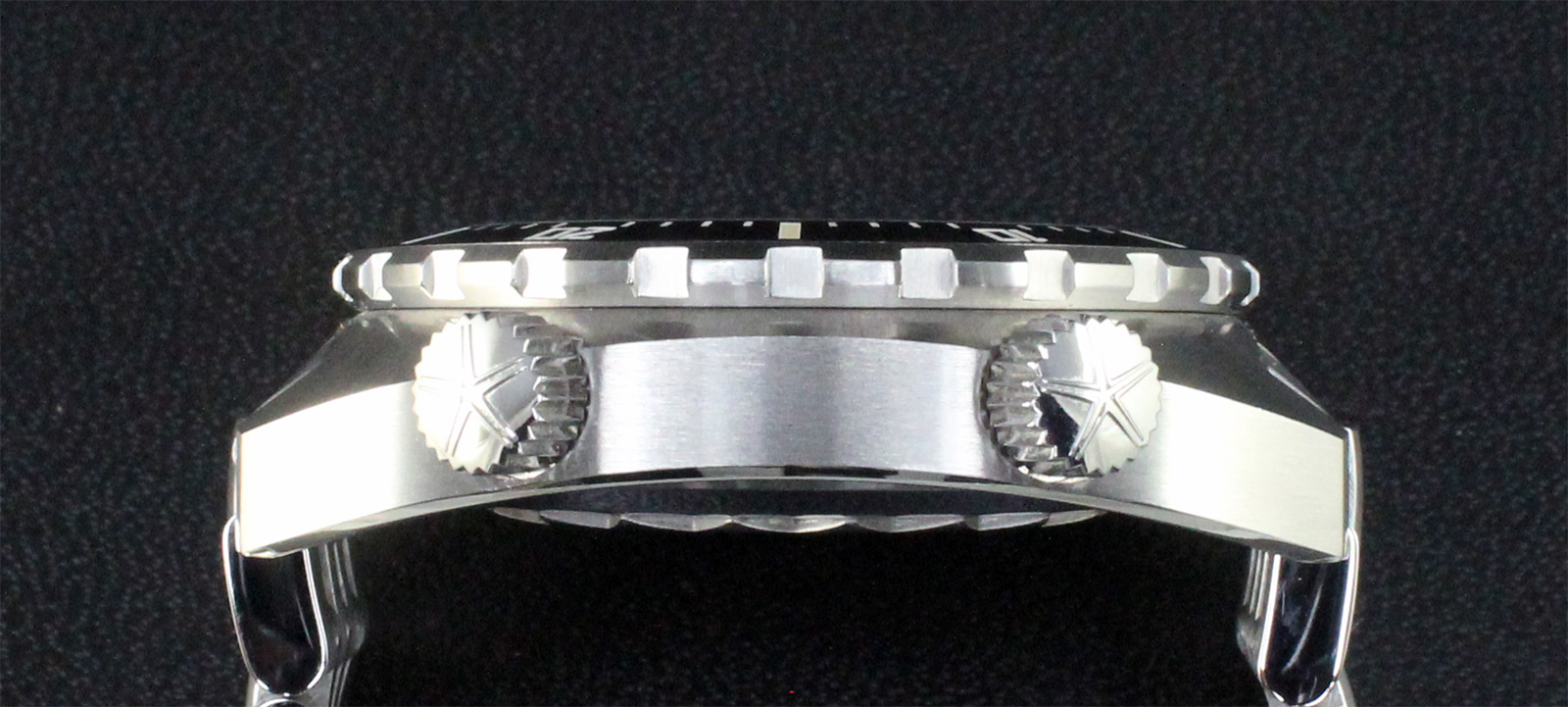
So how does it wear compared to the H1 and 500? Well, the side profile image above should give the game away!
The fact that the caseback and ends of the lugs are all on the same plane means the watch almost welds itself to your wrist. I have a smallish 6.75 inch wrist, and I also tend to wear the bracelet quite loose so the watch sits below the head of the Ulnar / Styloid Process on my wrist. A heavier watch will move about, so probably not a surprise I like thinner watches with flatter casebacks because there is more surface area in contact with my wrist and the watch doesn’t move so much.
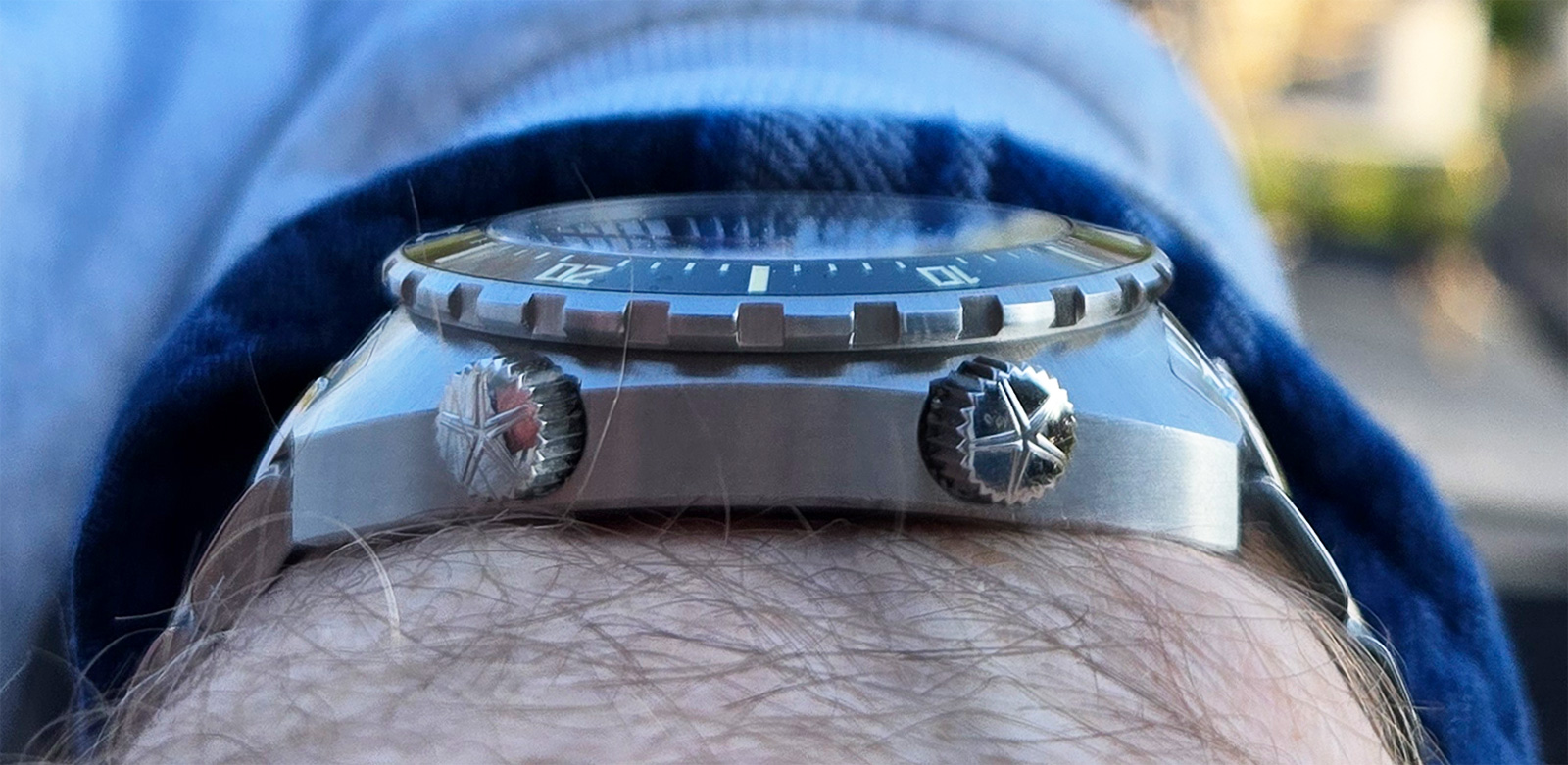
The H2 meets all my wearability criteria and is an absolute pleasure to wear. My wearability champ has to be the old Omega Seamaster 300. It hugs the wrist like a limpet. Well, watch out Mr Omega, the Benthos H2 is gunning for your title!
When I first saw the design for the Benthos H1 and the 2 o’clock crown, I have to admit, I was a bit unsure of the look. I even went to the extent of mocking up a GMT version with another crown and said to Rick Marei, put in a HEV at 4 o’clock just to balance the aesthetic. My mockups are shown below. Rick said no, he wanted to have the design hark back to the vintage Benthos 500, which is why he didn’t do a 3 o’clock crown. When the watch came out and I got to wear it, I had to agree with him, it was the right choice and it defines the Benthos look, but for me, the symmetry just wasn’t there. Well, with the H2, it is and it looks fantastic.
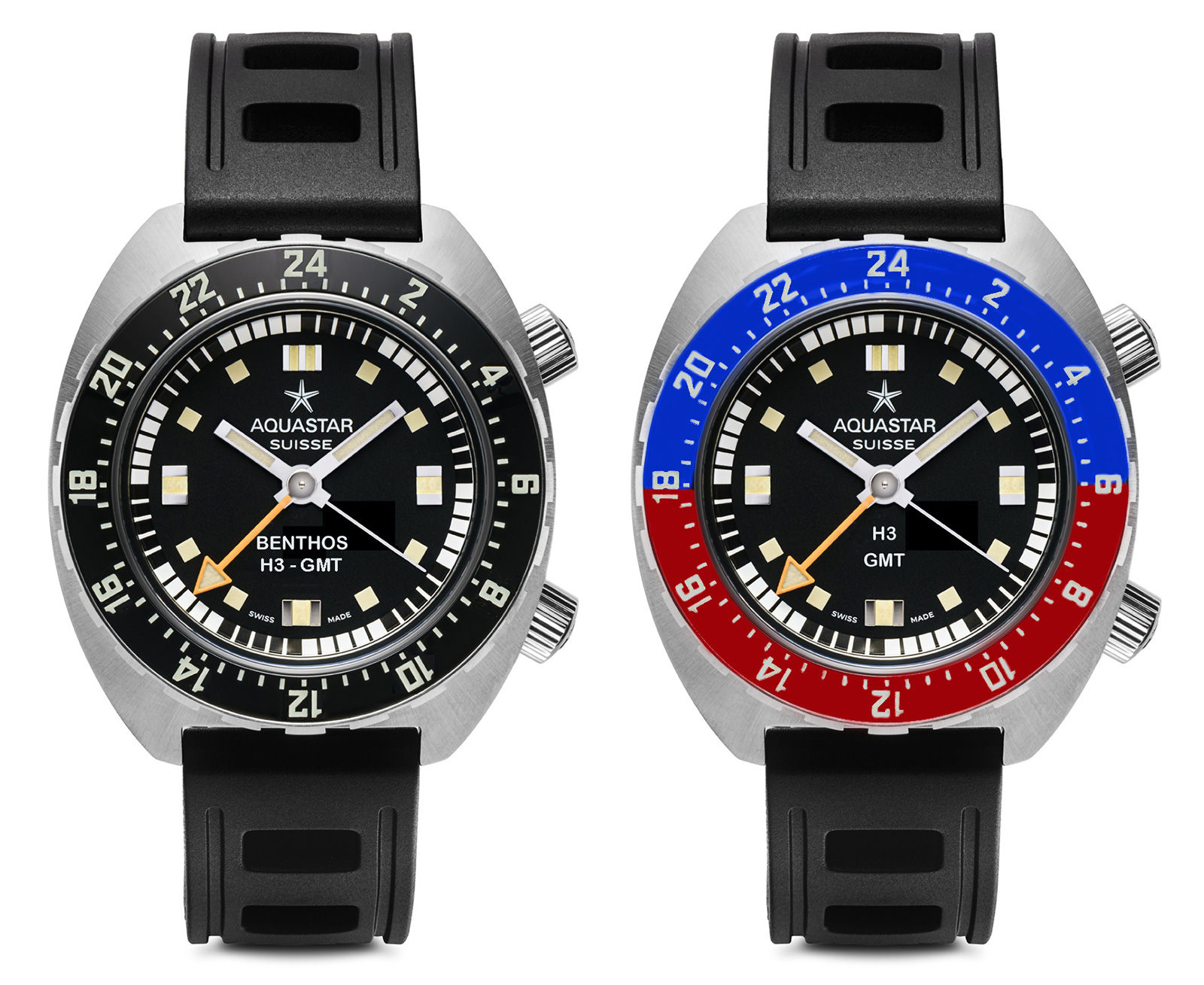
Regarding the HEV, I’m probably going to upset a bunch of people here. They seem to think that a dive watch is not a dive watch without a HEV. But here’s the thing, will the majority of people who buy a watch with a HEV be open water, recreational SCUBA divers? Probably not. Even if they are, I’ve got some bad news for them, HEVs are of absolutely no use to someone who is just a SCUBA diver. They were designed for professional saturation divers and even for “Sat” divers they’re actually not particularly useful either when all you have to do is unscrew and pull out the crown of your dive watch periodically during your decompression program. For me, HEVs are probably the greatest non event in dive watch history, BUT and it is a big BUT, they still are a pretty cool piece of engineering and just about everyone puts one on one of their dive watches. And yes, that is the vintage DOXA SUB 300T Conquistador in the next shot.
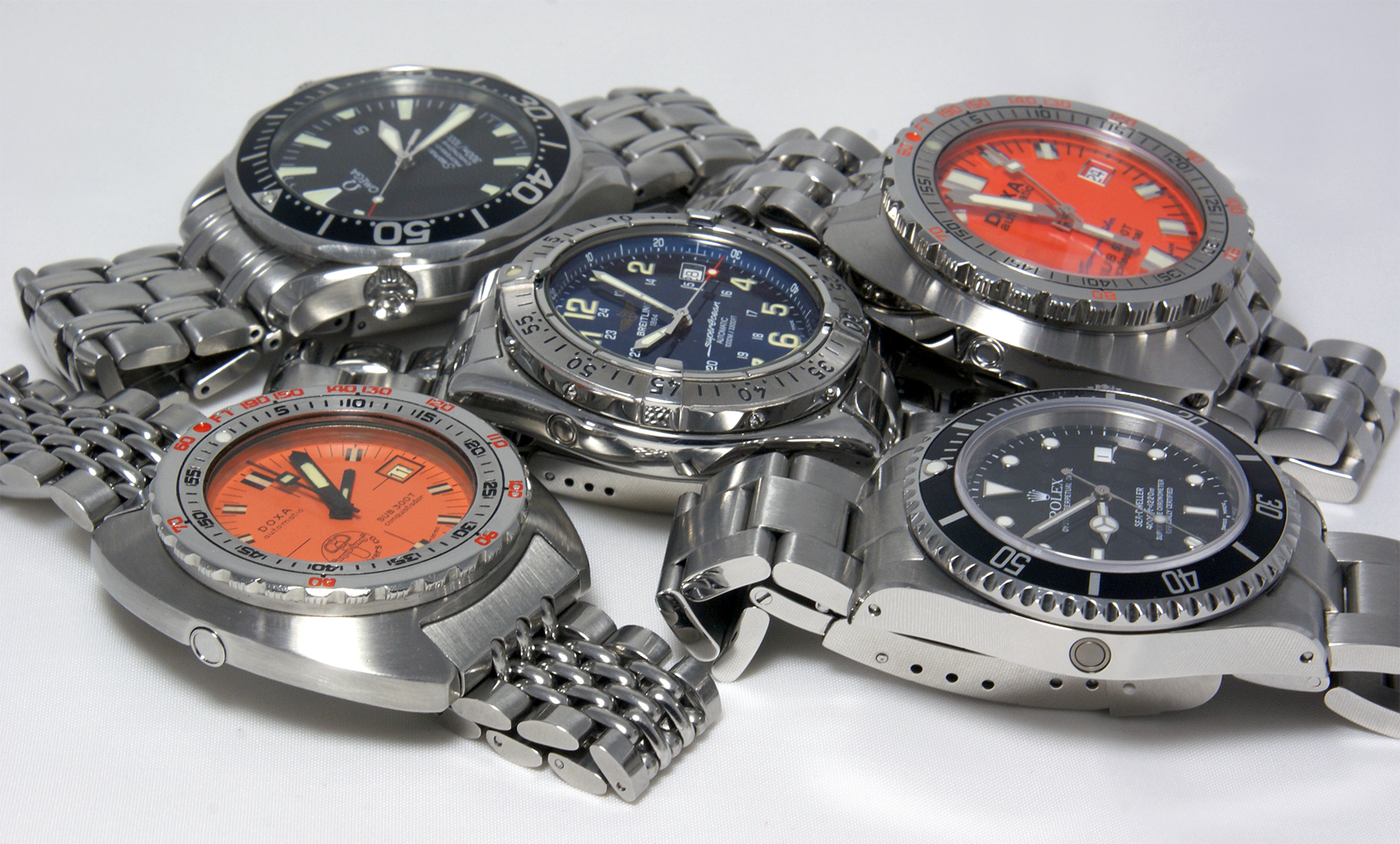
So, it was inevitable that Aquastar would add one to one of their watches and the 4 o’clock crown was the perfect location. Most people will look at it and assume it is the same HEV as on the Omega Seamaster. It isn’t. The following drawing shows the Omega HEV. If you follow the gas path in the open position you will see that it is possible for water to enter through the crown threads if is unscrewed underwater. Now why you would want to do that is anyone’s guess, but there could be a possibility where you didn’t check the crown before splashing and it was loose. Potentially flooded watch. I don’t have the General Arrangement drawing for the Benthos H2 HEV, but it is a modified design which prevents water ingress in that situation.
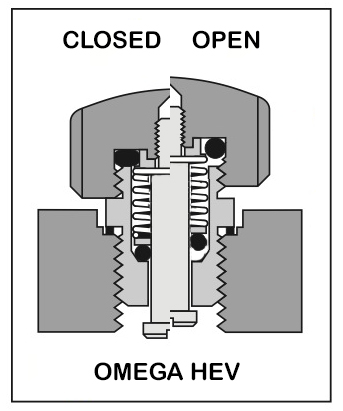
Most people will never touch the HEV crown other than unscrew it from time to time to clean any dirt around the bottom of the tube and crown. I have a prototype and on it both crowns are the same. The production watch is expected to have a slightly different HEV crown. Maybe the letters He on the top of the crown to differentiate it from the winding crown. He is the atomic symbol for Helium.
There is another change from the H1 which most people won’t notice and that is the hands. The hour hand has decreased in length slightly and the minute hand increased slightly. A few comments about the H1 pointed out that the hands were too similar in length and could be confusing when reading the time. There shouldn’t be any problem now with the change in length of the hands.
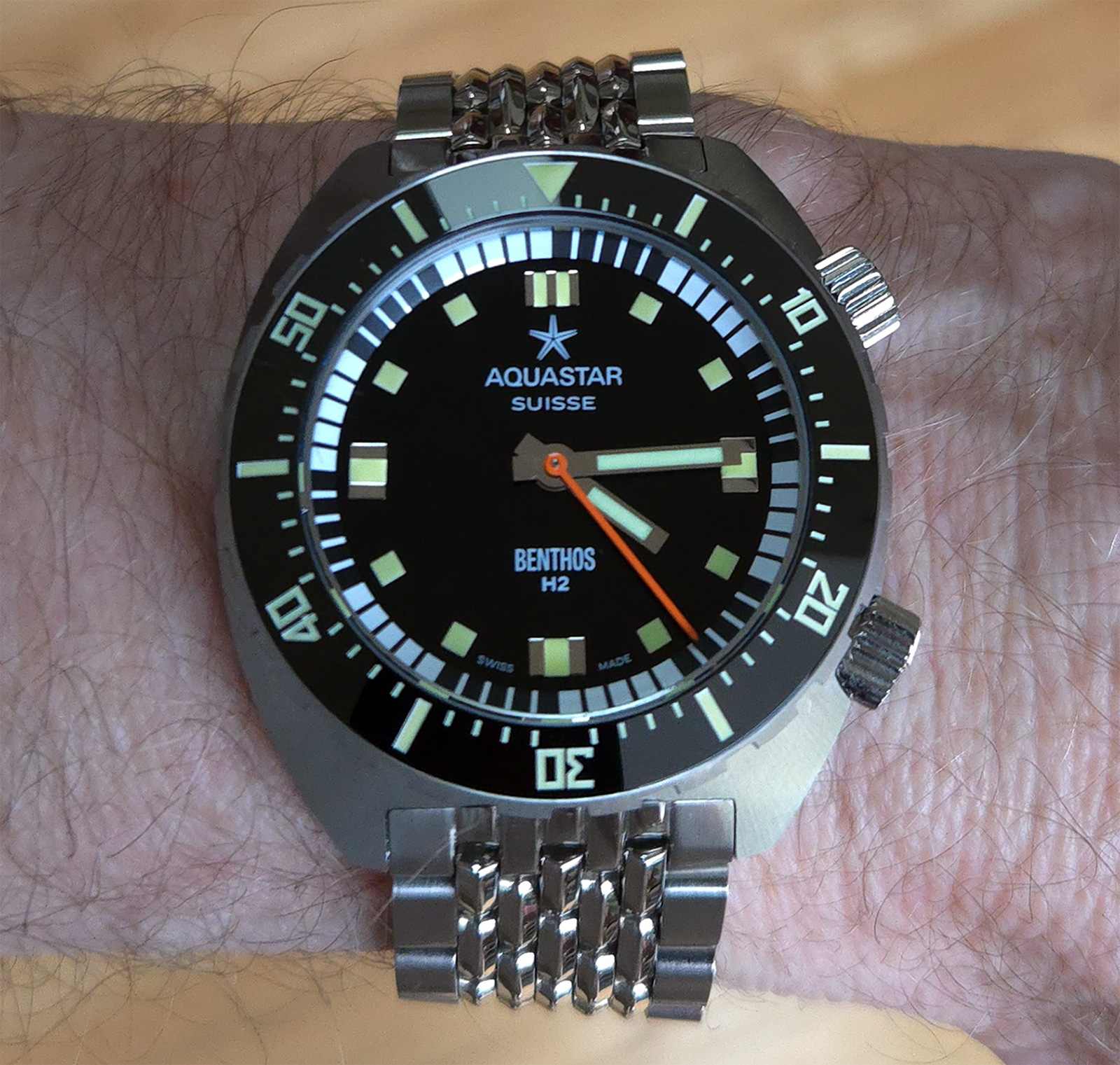
The H2 ships on either an Isofrane strap or a Beads of Rice (BOR) bracelet. I’ve said it before, every man and his dog now uses BOR bracelets. They are a good look, but, and this is my one criticism of the new H2, the faux BOR endpieces, I just don’t think they work with the Benthos case. I ground the endpieces on my Benthos 500 flat and brushed them. You can see what I did in the image above showing the 3 Benthos generations. Not the greatest job in the world but I think it is a far better look. So why don’t Aquastar just make brushed endpieces? The argument has always been that the Benthos case uses radial brushing. In order to get the endpieces to look perfect they would have to be installed on the case when the case is radially brushed. The bracelets are not made by the case manufacturer so there is another step in the whole production process. Obviously, it is easier to just use faux BOR endpieces. However, I always felt that if flat endpieces were made with vertical brushing they would be a good match for the case. Well take a close look at the following close up of the H2 endpiece. It is almost brushed. I can see my sandpaper coming out to brush the polished parts of the endpiece and maybe I’ll just go the whole hog and dremel the faux BORs flat. This is how it would look.

I’m not a strap guy but for the sake of completeness, I put the H2 on an isofrane. Here is a pic with it flat on the deck.
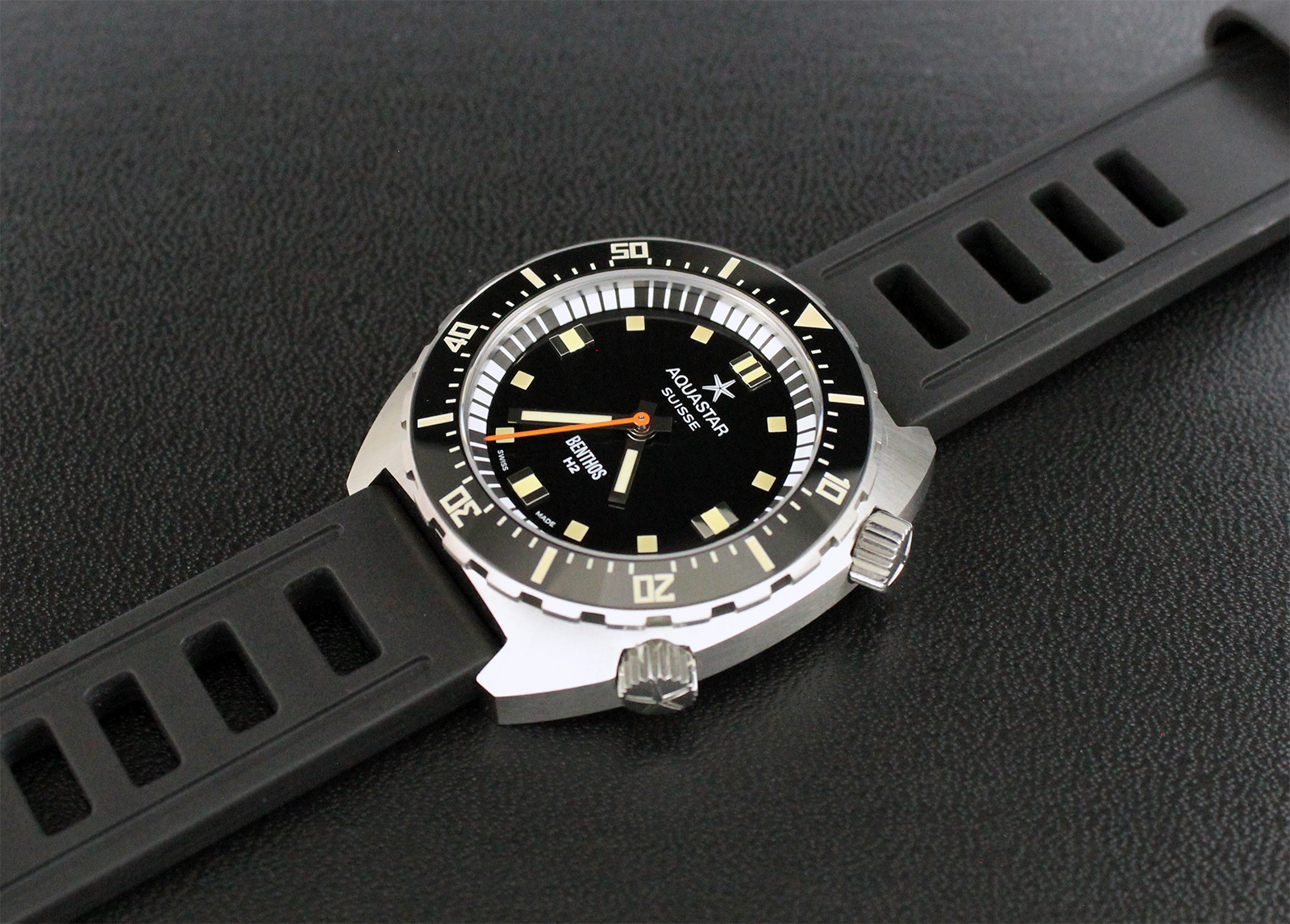
And one on my wrist. It certainly is a good look.
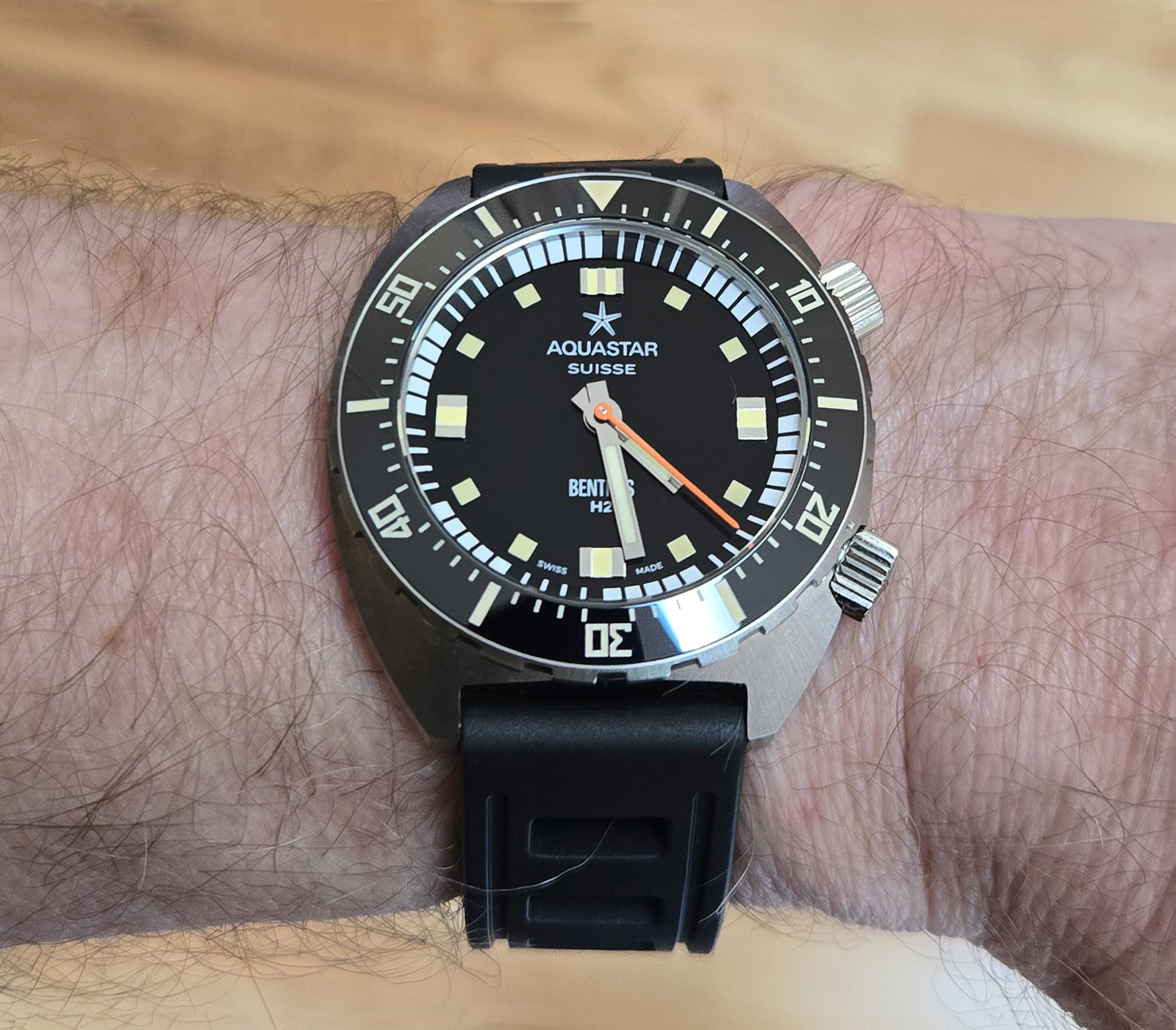
If you have read any of my other Benthos reviews you will know I have a certain fondness for the $20 Amazon bracelet that you will see on most of my Benthos watches.
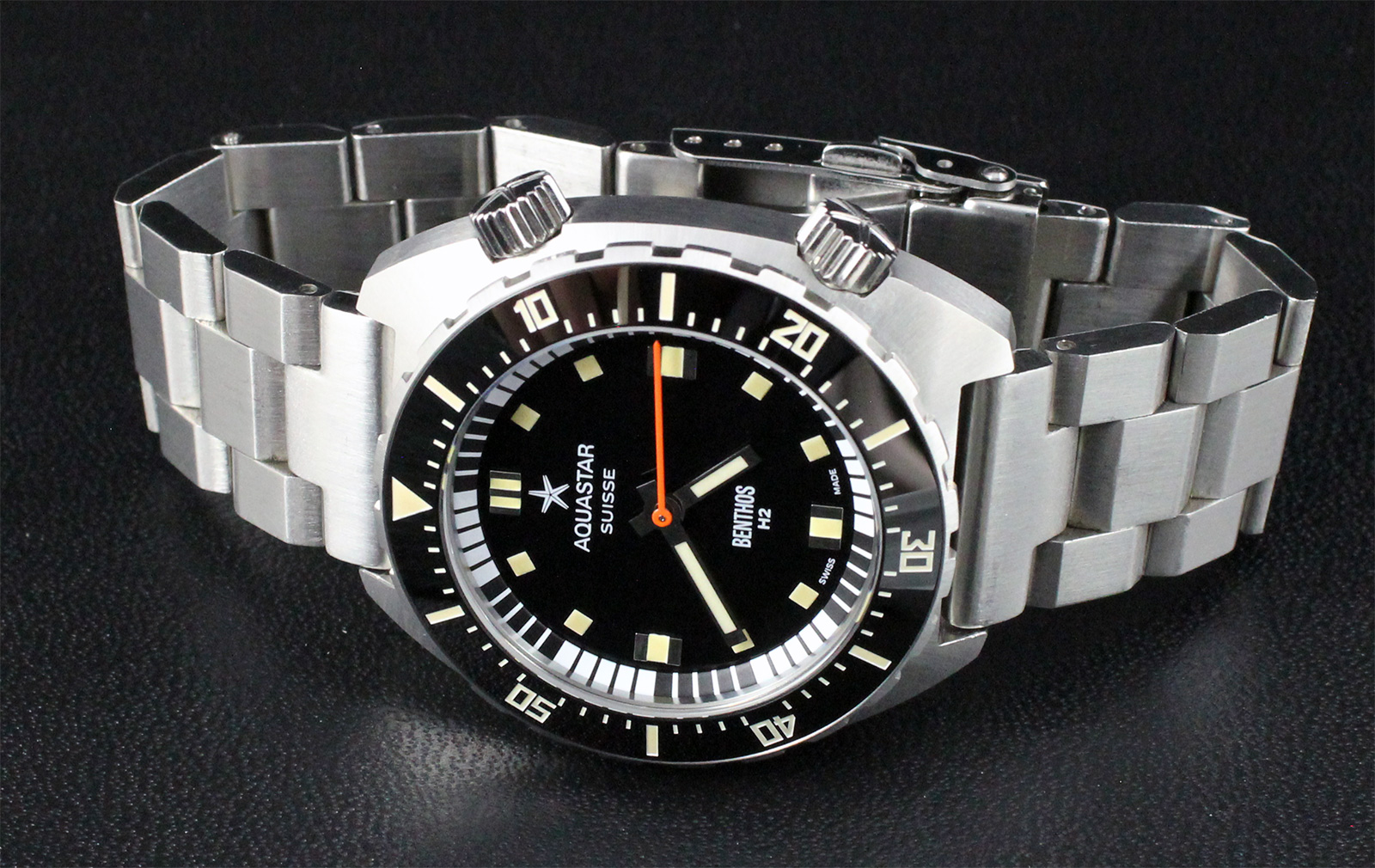
It has that chunky, tool watch vibe and I think it is a great match for the H2.
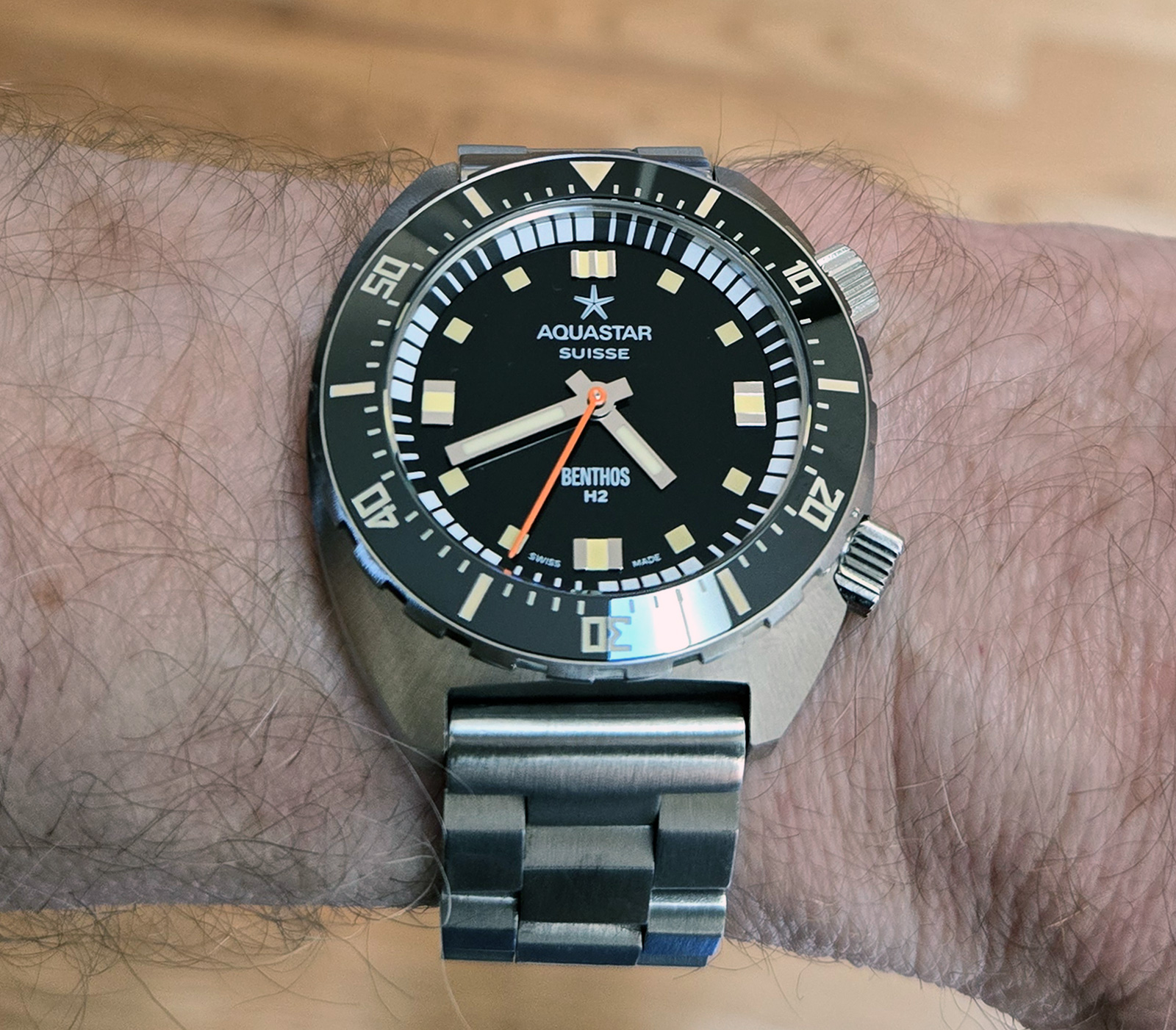
Here is the link to the bracelet
The one “negative” I have with the H2 is the use of the vintage lume color. It’s become the Beads of Rice of the lume world. The same men and their dogs are now using it. If I wanted a watch with faded, degraded lume and a washed out aged color, I’d buy a vintage watch. OK, I get it when a remake of a vintage watch is released and the manufacturer wants to give it the vintage look so they use the aged radium lume color, but the H2 is a new design. Aquastar never made one before so why go with the aged lume? BUT and it is a big BUT, would the watch have looked better with white lume on the hands, indices and bezel? Well, I decided to find out. As I was writing this review, Aquastar released a version of the H2 with a blue dial and bezel and it uses much lighter lume.
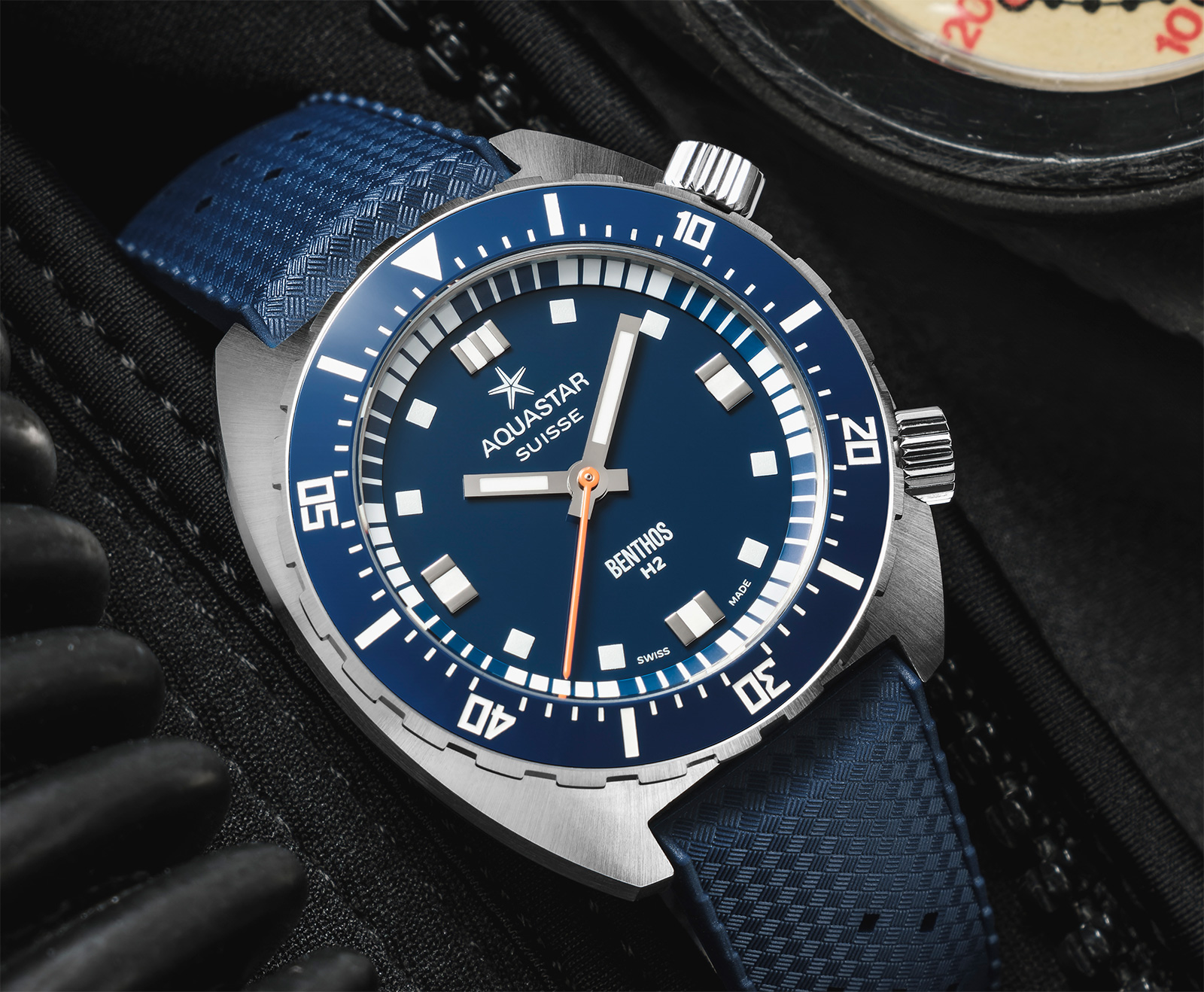
I “shopped” the following image which shows the blue H2, the prototype I have and one with whiter lume. I prefer the whiter lume.
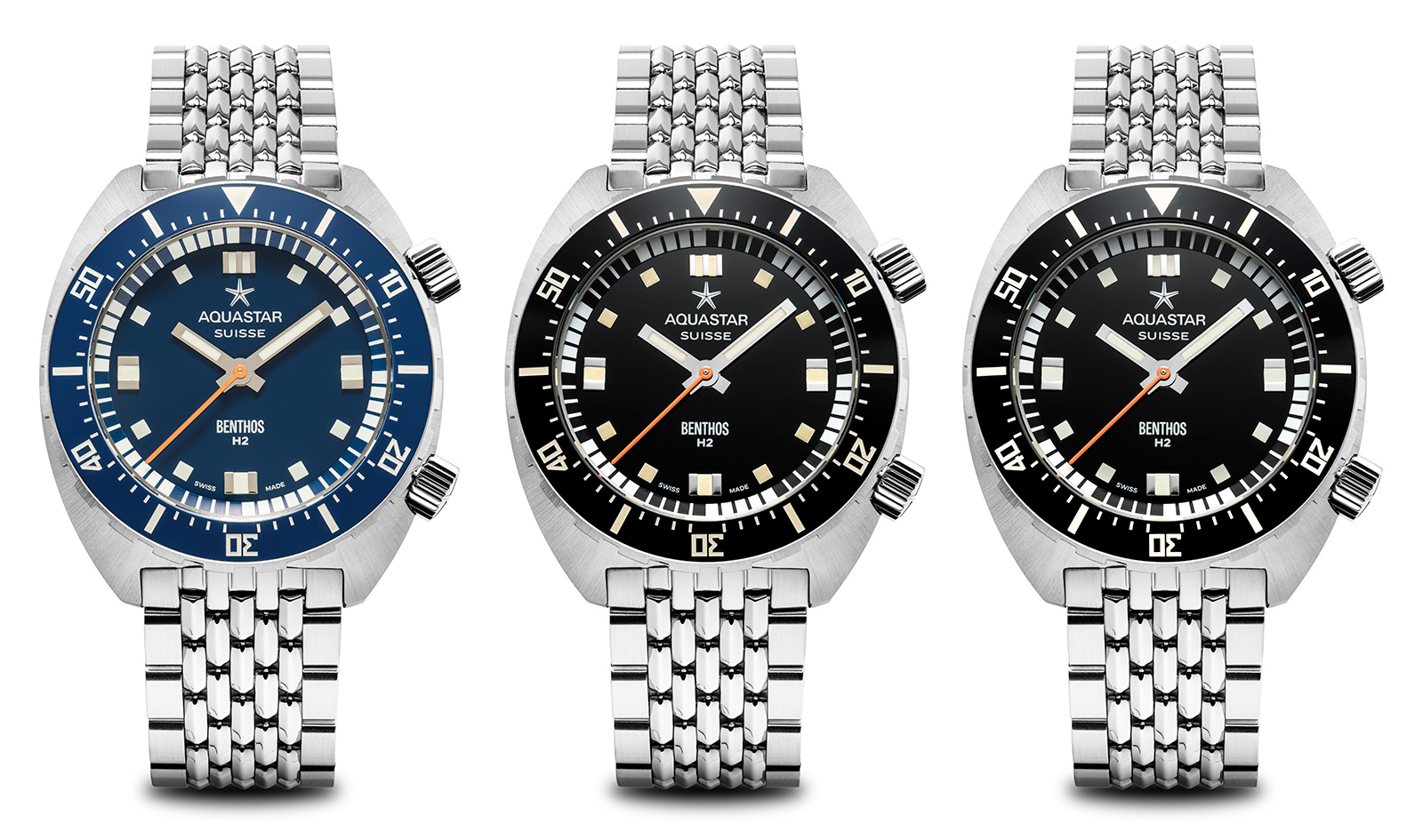
And while we are talking about the lume, here is the obligatory lume shot. Bit of an unfair comparison with the Seiko Monster as it is the lume king, but the H2 lights up well.

I think Aquastar hit the Benthos “Goldilocks” spot with the H2. It wears remarkably well. The 45mm lug to lug and the dual crowns give it the presence of a 42mm watch. The inky black glossy dial is wonderful and I think that the H2 would be a great base for future models including a date version, which I mocked up below and a GMT.

I’ve always thought of the Benthos 500 as the epitome of a diver’s tool watch. Big, tough with the added functionality of a Totalizer. The H2 is still unquestionably a tool watch but there is an elegance about it that the 500 and H1 just don’t have. Maybe it is the reduced size and thickness and increased wearability and maybe it is the symmetry of the dual crowns. I don’t know what. There is a French expression: “Je ne sais quoi” that stands for something with a sort of indefinable quality that can not be expressed or adequately described, and that really sums up the Benthos H2 for me. It is my favorite Aquastar, even beating out the vintage Benthos 500. Now that says something.
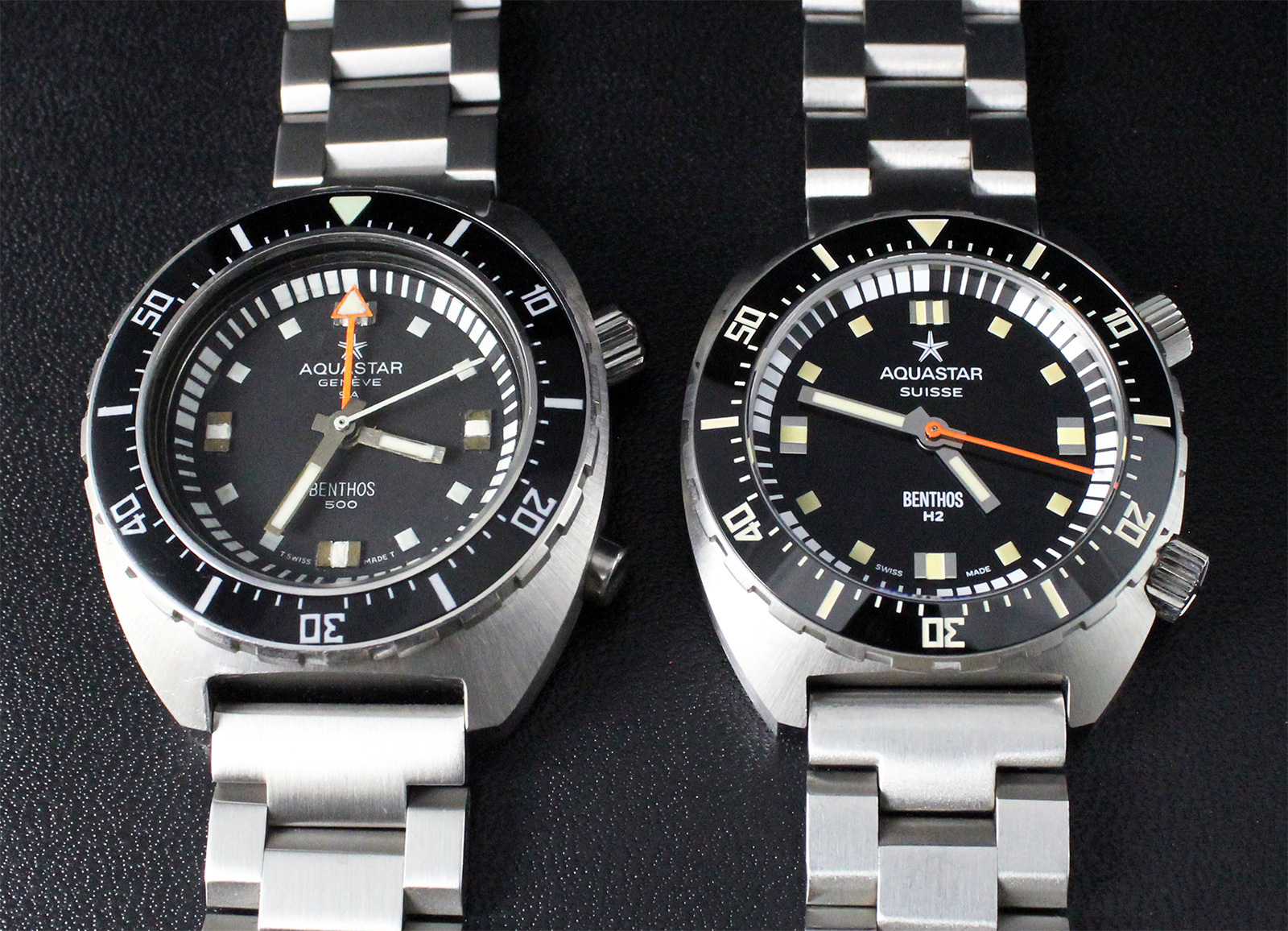
But, I’m sure she would approve.
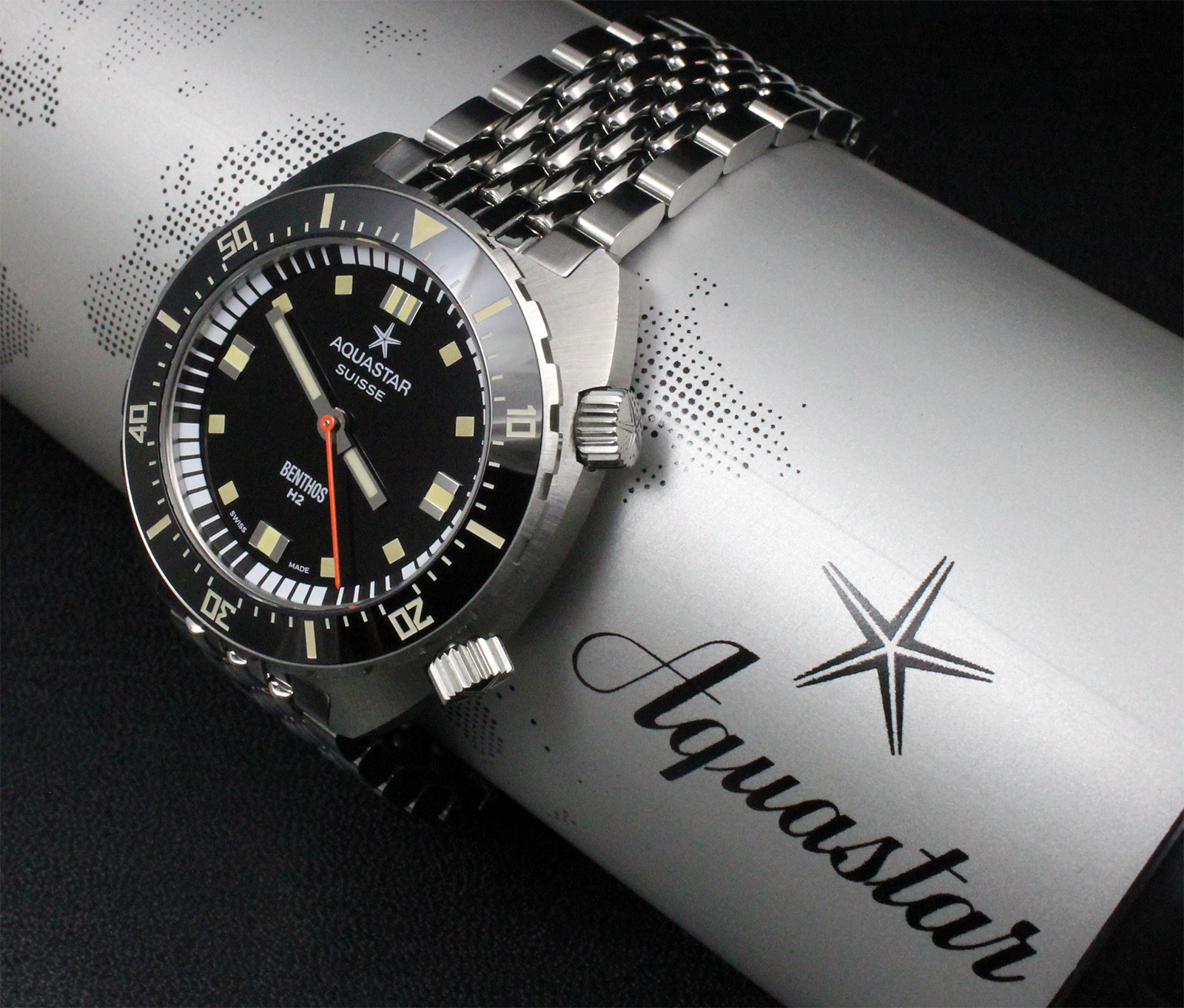
The Benthos H2 is a Limited Edition of 500 watches and is available from Aquastar for US$ 1,390 with the Isofrane strap or $1,490 with the BOR bracelet.